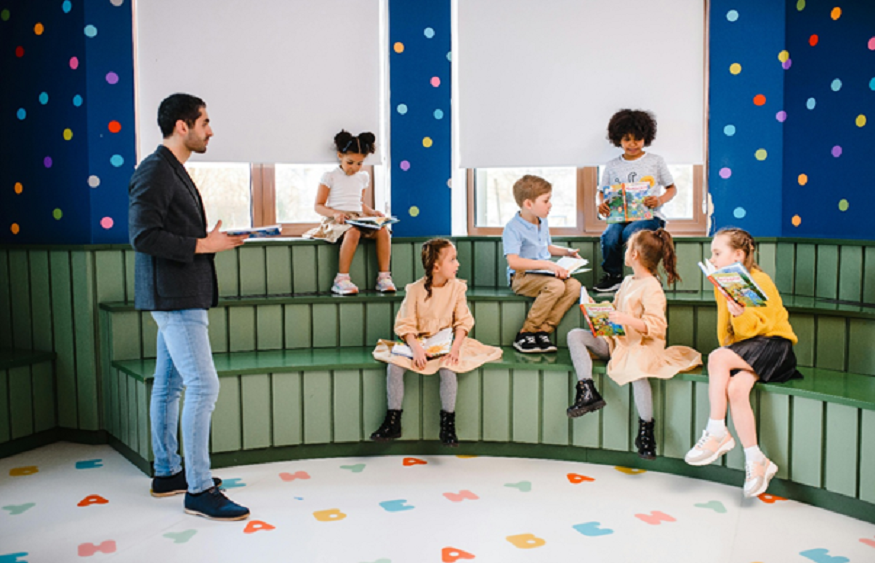The world of education is ever changing, and even the most engaging lessons can sometimes lead to waning attention spans. That’s where quick, five-minute classroom activities come in. These mini-energizers serve as mental refreshers that boost focus, ignite creativity, and create a positive learning environment. What’s more, they are simple to implement, need minimal materials, and make a big impact on student morale and participation. As teachers who have completed Primary Teacher Training Courses, here are a few activities to try for fun learning.
5-Minute Fun Activities For Your Students In The Classroom
Here are a few activities that are quick bursts of fun to refresh minds and refocus your classroom in just 5 minutes:
1. Vocabulary Hot Potato
Students form a circle and pass around a soft ball while music plays. When the music stops, the student holding the ball must quickly say a word from a pre-decided category, such as ‘animals’ or ‘verbs.’ If the student can’t respond in five seconds, they sit out for the next round.
Why It Works
This activity blends physical movement with cognitive recall, helping students develop vocabulary fluency and active listening. The quick pace keeps everyone engaged, and the rotating categories ensure it never feels repetitive. It can also be aligned with subject-specific vocabulary, reinforcing recent lessons in a fun way.
2. Math Minute Madness
Prepare a sheet or digital slide of quick math problems suitable for your students’ grade level. Set a one-minute timer and have students work individually or in pairs to solve as many problems as they can. This can involve operations like addition, subtraction, or multiplication based on current learning goals.
Why It Works
This rapid-fire activity strengthens students’ mental math skills while applying mild time pressure. It introduces a healthy sense of competition, keeps students alert, and reinforces numerical fluency. The short time frame makes it an ideal choice during math transitions or right after recess.
3. Science Fact or Fiction
Present a list of science-based statements—some true, some false. Students must vote or signal whether they think each statement is a fact or fiction. Encourage brief discussion after each one to reveal the correct answer and explain the reasoning.
Why It Works
This activity builds critical thinking and teaches students to question information rather than take it at face value. It supports inquiry-based learning and helps reinforce science concepts in an engaging, interactive way.
4. Historical Figure Showdown
Write the names of well-known historical figures on slips of paper. Each student picks one and provides verbal clues to describe their figure’s accomplishments, without naming them. The rest of the class tries to guess who it is.
Why It Works
By prompting students to recall key facts creatively, this game boosts memory retention and deepens historical understanding. It turns passive recall into active learning and adds a performance element that appeals to verbal learners.
5. Famous Quote Match-Up
Split famous quotes in half and distribute one part of each to different students. Their task is to move around the room, find their match, and present the complete quote to the class.
Why It Works
This activity enhances comprehension, encourages movement, and introduces students to literature or history in a collaborative format. It’s a great tool for integrating cross-curricular learning.
6. Spelling Bee Blitz
Call out words one by one, giving each student 15 seconds to spell aloud. If they get it wrong, the turn moves to the next student. The game can be played individually or in teams.
Why It Works
This high-energy spelling game boosts focus, listening, and language accuracy. The short time limit and team-based design make it fun and fast-paced, ideal for winding down or breaking up a grammar lesson.
7. Math Flash Challenge
Flash quick math problems on a board or screen. Students shout or write down the answer as fast as they can. Points can be awarded for both speed and accuracy.
Why It Works
It encourages fast thinking and helps reinforce math fluency. The gamified nature keeps enthusiasm high and offers a welcome alternative to traditional drills.
8. Quick Science Experiment Guess
Present a common item or demonstration (like a magnet or water in a glass) and ask students to predict what will happen next. After guessing, experiment, and reveal the outcome.
Why It Works
This activity stimulates curiosity, hypothesizing, and scientific discussion. It transforms abstract science into concrete experiences, making lessons memorable.
9. Rapid Fire Capitals
Call out the name of a country and have students quickly shout the capital—or vice versa. You can make it team-based or individual.
Why It Works
It sharpens geography skills and promotes global awareness. The quick pace ensures attention and encourages students to expand their knowledge beyond textbook maps.
10. Current Events Flash Quiz
Ask rapid-fire questions about current global or local news. Students answer verbally, in teams, or on small whiteboards.
Why It Works
It enhances awareness of the world and creates informed learners. Students begin to see classroom learning as connected to real-world issues.
Benefits of 5-Minute Activities in the Classroom
Here are some of the benefits of 5-minute activities that can uplift your classroom in no time:
-
Boost Energy and Attention
Students often experience dips in energy, especially after long lessons or during transition periods. Five-minute activities act as quick resets that help them shake off fatigue and re-engage with the material. These bursts of movement or mental stimulation refresh their focus and enthusiasm, creating a more attentive classroom environment.
-
Enhance Learning
Short games or challenges that incorporate academic content make learning feel less like a task and more like an adventure. Whether it’s through vocabulary games or rapid-fire math problems, students reinforce core subject concepts in a fun and memorable way. These activities also build long-term retention through repetition and application.
-
Encourage Collaboration
Many of these short activities are team-based or involve partner interaction, helping students build interpersonal skills. They learn to communicate, cooperate, and problem-solve together in low-pressure settings, contributing to a more cohesive and socially aware classroom culture.
-
Support Diverse Learning Styles
Every student learns differently. Five-minute activities allow teachers to cater to a variety of learning preferences, whether that’s auditory, visual, or kinesthetic. For instance, a spelling game may appeal to auditory learners, while hands-on science predictions cater to kinesthetic ones. These quick strategies are often included in Primary Teacher Training Courses, where future educators learn to implement inclusive and responsive teaching practices.
Tips for Smooth Implementation
Here are some of the effective tips to implement these 5-minute activities:
-
Plan Ahead
Keep a set of pre-prepared, easy-to-implement activities handy. These can be written on cards, stored digitally, or included in your lesson planning book to ensure smooth transitions.
-
Set Clear Expectations
Before starting any activity, take a moment to explain the rules clearly and establish behavioral expectations. This reduces confusion and allows the session to run efficiently.
-
Keep it Short and Sweet.
Stick to the five-minute time frame to maintain flow and avoid disrupting the overall lesson plan. You can use a timer or assign a student to be the official “timekeeper.”
-
Use Transition Times Wisely
These activities are perfect for use between subjects, after recess, or as an energizer before a test. They offer just the right mental break students need to refocus without derailing the lesson.
These methods are also emphasized in the Diploma in Pre and Primary Teacher Training Course, where educators are taught to master classroom flow and use micro-activities to support better engagement and behavior management.
Bottom Line
Incorporating five-minute fun activities can significantly improve classroom engagement. It’s a small change with a big impact. These brief, lively sessions enhance concentration, promote learning, and make education enjoyable. For teachers enrolled in a Diploma in Pre and Primary Teacher Training Course, mastering such innovative tools equips them to create dynamic, inclusive classrooms that meet the needs of today’s learners.
So next time your class feels drained, consider one of these power-packed activities. Sometimes, five minutes is all it takes to turn the classroom energy around.





